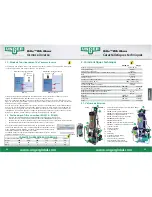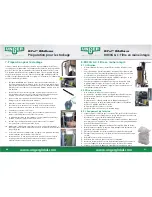
www.ungerglobal.com
www.ungerglobal.com
28
29
ENGLISH
H
I
F
LO
™ RO-M
OBILE
Notes
H
I
F
LO
™ RO-M
OBILE
Function overview
9. The integrated TDS meter
9.1. Use
•
Press the “POWER“ button to activate the unit.
•
RO30G/C: To show the value of the incoming pure water in the resin fi lter, press “IN“. This
value shows the quality of the water after fi ltering through the osmosis fi lter. The value of
the fi ltered, outgoing water downstream the resin fi lter is shown with “OUT“.
•
RO60S: The diode for the inlet value “IN” has been connected directly downstream the pre-
fi lter and the diode for the outlet value “OUT” downstream the membranes. Thus, you are
measuring the value of the incoming water and the water fi ltered by the system.
•
The value takes a little time to adjust. The most precise value is indicated after approx. 10
seconds.
•
When the “x10“ indication appears, a value of over 999 ppm has been measured.
Now multiply the value indicated by 10.
If then, e.g., “143“ is indicated in this mode, the correct value is 1430 ppm
.
•
The TDS meter switches off automatically after approx. 30 seconds.
9.2. Care
•
In principle, this TDS meter does not require any care. Nevertheless, the following points
should be observed:
•
Never touch the sensors, as the oil in the skin can affect the correct TDS values.
•
Use alcohol to clean the sensors and allow them to dry in the air.
•
If you fi nd that the values indicated can no longer be correct, replace the batteries.
9.3. Replacing the batteries
•
If the display becomes pale or shows faulty indications, the batteries should be replaced.
1.
Unscrew the four metal screws (not the plastic screws) on the bottom and remove the
panel.
2.
Remove the batteries.
3.
Always replace both batteries (Type AA). Ensure that the polarity is correct.
4.
Close the panel again and screw it tight. It is not necessary to recalibrate the device.
10. Pump control system
The pump control system is in the black box on the right above the pump.
The unit is reset and restarted with the red button. This is, e.g., necessary
if there is too little pressure at the inlet.
















































